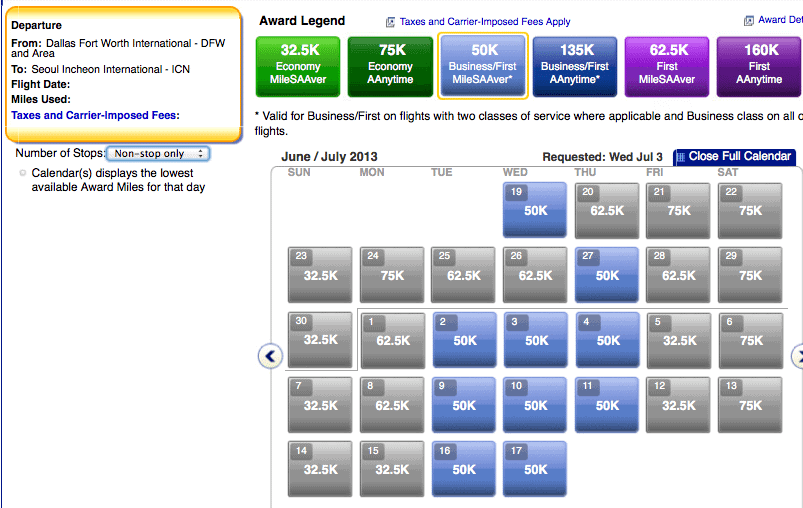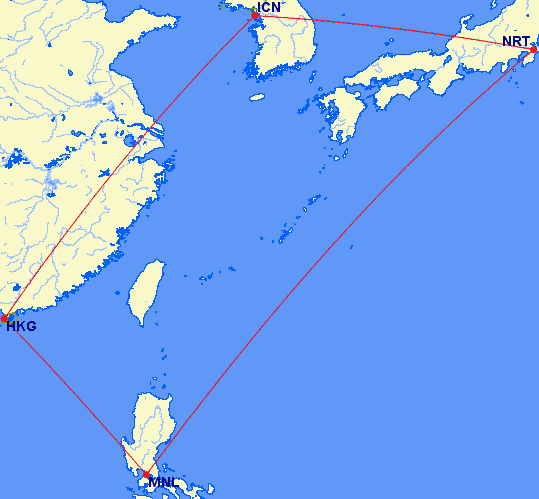MileValue is part of an affiliate sales network and receives compensation for sending traffic to partner sites, such as CreditCards.com. This compensation may impact how and where links appear on this site. This site does not include all financial companies or all available financial offers. Terms apply to American Express benefits and offers. Enrollment may be required for select American Express benefits and offers. Visit americanexpress.com to learn more.
Note: Some of the offers mentioned below may have changed or are no longer be available. You can view current offers here.
This is the third part of a multi-post Anatomy of an Award series about American Airlines Explorer Awards, which are ideal for around-the-world trips, trips with multiple destinations, and other “trick” itineraries. Previously: Planning
My client’s first stop was Asia, but it didn’t much matter whether the first city was Seoul, Tokyo, or Hong Kong. He had a specific summer date in mind to start his month-long trip, but he had flexibility to begin a few days later if award space required. I set about to search the options into all three Asian metropolises.
Raleigh to Hong Kong
The most important thing to my client was a comfortable trip. That meant short travel times and a good product. My first thought was to take him Raleigh to Hong Kong on American Airlines first and Cathay Pacific business on a two-segment itinerary.
My favorite place to search for Cathay space is ba.com. I attacked this award search the same way I attack any.
1. First I do the simple search. On ba.com, I just searched his date and Raleigh (RDU) to Hong Kong (HKG.) If ba.com could do the work of finding an itinerary for me, that would be ideal.
2. If that fails, I do the segment-by-segment search. Search engines are imperfect and often fail to return all the valid routings. That’s where a brute force technique comes in handy.
The possible one-stop routing options would be determined by the overlap in American’s route map from Raleigh and Cathay’s from Hong Kong.
Cathay’s US destinations: Chicago, Los Angeles, New York-JFK, San Francisco
AA’s Raleigh destinations: Chicago, Dallas, London, Los Angeles, Miami, New York-LGA, Washington-DCA
I would search all the flights from Chicago, Los Angeles, and New York to Hong Kong on my client’s preferred date. If I found space, then I would search for space from Raleigh to the gateway city on aa.com.
Why do I start my searches with the transpacific Cathay segment? I start with the transpacific segment because it is less likely to have award space.
When I do the domestic-segment search on aa.com, I make sure to search both domestic first class and economy class. Sometimes only an economy class seat is available on a short domestic segment that connects to a beautiful business class on a long international segment. Most people find that to be a trade worth making, so I make sure to check for economy seats on domestic flights when I’m booking international business awards.
Neither method–simple or segment-by-segment–found any award space on my client’s preferred date. I did find space two days later. I knew that could work as a last resort, but I wanted to check space to Seoul and Tokyo before reserving it.
Raleigh to Seoul
American Airlines announced in October 2012 that it was launching daily Dallas to Seoul flights starting May 9, 2013. At the time, I surveyed the award space on the flight and found that most Tuesday through Thursday flight had a pair of business class award seats available.
That pattern was the same when I did the award searches last week. Unfortunately my client wanted to leave on a Friday, and couldn’t leave earlier, so this option to Seoul wouldn’t work. The Cathay flight would get him on his way a few days earlier and in a better product.

I was bummed because routing-wise RDU-DFW-ICN was the ideal start. If he went to Seoul first, he could go on to Tokyo then Manila then Hong Kong all on direct flights, leaving him at a oneworld hub with direct flights to the Middle East. This would have been that perfect routing you dream of, but flying to Hong Kong or Tokyo first was acceptable and would only add one segment to the entire trip.
Raleigh to Tokyo
Raleigh to Tokyo would rely on the a Japan Airlines flight to Tokyo, searching for the space was an identical process to searching for space from Raleigh to Hong Kong using Cathay.
First I searched ba.com for RDU-NRT. Nothing came up, so I moved to a brute force method identifying overlap in AA’s route network from Raleigh and JAL’s route network in the US.
JAL flies to Boston, Chicago, Los Angeles, New York-JFK, San Diego, and San Francisco.
I first checked for JAL space on ba.com from Chicago, Los Angeles, and New York, the cities where AA had direct flights from Raleigh. Finding none, I moved on to Boston, San Diego, and San Francisco.
I did find space out of San Diego, but the flight leaves so early (1:30 PM) that I couldn’t match the flight up with space from Raleigh that day. To use the JAL space, he would have to fly two segments into San Diego, spend the night, then continue on a JAL flight.
Since the JAL flight was the same day as the Cathay flight with space, he gave up his chance to fly a JAL Dreamliner in favor of the Cathay space that routed RDU-ORD-HKG two days after his ideal departure.
Intra-Asia
Now we knew where and when he would touch down in Asia. The intra-Asia legs were pretty easy. Remember in Planning I talked about the importance of spacing hubs two cities apart for maximum direct flights. That meant that if Hong Kong was the first city, Tokyo would be the third, placing Manila and Seoul second and fourth.
The flight between Hong Kong and Manila was on Cathay. The flights between Manila and Tokyo and Tokyo and Seoul was on JAL. I searched for all flights on ba.com.
All the routes had space the days we wanted in business class. This is exactly what I anticipated. Intra-Asia, intra-Australia, intra-Europe, and intra-South America space is usually wide open on all carriers.
The one interesting note from the intra-Asia searches is that JAL has a Narita to Incheon flight and a Haneda to Gimpo flight. I ran both options by my client, and because the “domestic” airports are closer to the city centers, he chose HND-GMP.
Choosing this flight added two segments to his count. Remember from the Rules that flying into one airport and out of another counts as a segment even if they are coterminal.
He was flying into Narita and out of Haneda (1) and into Gimpo and out of Incheon (2).
If my client had been brushing up against his 16-segment limit, we would have booked NRT-ICN instead to save two segments, but since he had segments to spare, he could choose the more convenient routing.
With all the space found to and within Asia, I called American Airlines to put the award space on hold. I will skip the details of that process now and talk more about it at the end of the posts on the searches.
Next: The Search to Europe
Just getting started in the world of points and miles? The Chase Sapphire Preferred is the best card for you to start with.
With a bonus of 60,000 points after $4,000 spend in the first 3 months, 5x points on travel booked through the Chase Travel Portal and 3x points on restaurants, streaming services, and online groceries (excluding Target, Walmart, and wholesale clubs), this card truly cannot be beat for getting started!
Editorial Disclaimer: The editorial content is not provided or commissioned by the credit card issuers. Opinions expressed here are the author’s alone, not those of the credit card issuers, and have not been reviewed, approved or otherwise endorsed by the credit card issuers.
The comments section below is not provided or commissioned by the bank advertiser. Responses have not been reviewed, approved, or otherwise endorsed by the bank advertiser. It is not the bank advertiser’s responsibility to ensure all questions are answered.






How is good is Expert flyer tool for routing? I tried it once during a demo and it didn’t find much, but maybe I was using it wrong.
It’s awful at routing. Way worse than any search engine. I use it for segment-by-segment searches or one stops through a hub only.
Ok. then I’m not stupid…i noticed it too. I’ll just use it to set reminders for biz tickets on direct long distance flights. Matrix with alliance option set has been much more useful.
[…] This is the fourth part of a multi-post Anatomy of an Award series about American Airlines Explorer Awards, which are ideal for around-the-world trips, trips with multiple destinations, and other “trick” itineraries. Previously: The Search in Asia. […]
I noticed you were searching milesaver. Is this the category needed to book this type of ticket?
Yes